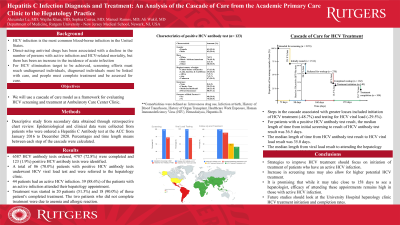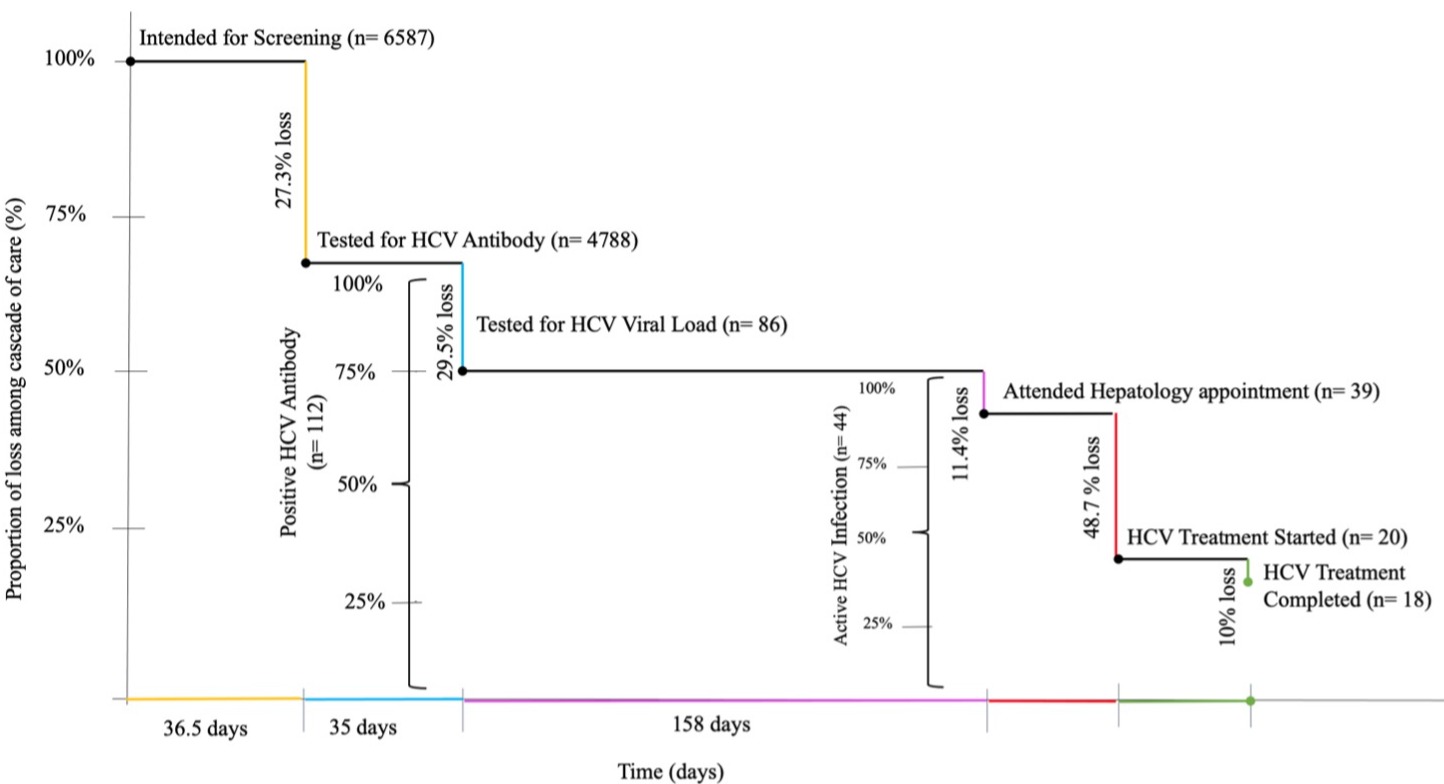Sunday Poster Session
Category: Liver
P0915 - Hepatitis C Infection Diagnosis and Treatment: An Analysis of the Cascade of Care From the Academic Primary Care Clinic to the Hepatology Practice
Sunday, October 22, 2023
3:30 PM - 7:00 PM PT
Location: Exhibit Hall

Has Audio

Alexander Le, MD
Rutgers New Jersey Medical School
Newark, NJ
Presenting Author(s)
Alexander Le, MD1, Wajiha Khan, MD2, Sophia A. Correa Bravo, MD1, Manuel Ramos Barrios, MD1, Sarah Shoeb, BS1, Ali Wakil, MD1
1Rutgers New Jersey Medical School, Newark, NJ; 2Rutgers, New Jersey Medical School, Morristown, NJ
Introduction: Hepatitis C virus (HCV) infection is the most common blood-borne infection in the United States. The World Health Organization (WHO) has set a target date for elimination as 2030. Screening efforts must reach undiagnosed individuals and diagnosed individuals must be linked with care. A cascade of care model was used for evaluating HCV screening and treatment at our University Ambulatory Care Center Clinic.
Methods: Data of patients who were ordered a HCV Antibody test at the Ambulatory Care Center Clinic from January 2016 to December 2020 was obtained through retrospective chart review. Percentages and time length means between each step of the cascade were calculated.
Results: Of a total of 6587 HCV antibody tests ordered, 4787 (72.8%) were completed and 123 (1.9%) positive HCV antibody tests were identified. A total of 86 (70.0%) patients with positive HCV antibody tests underwent HCV viral load test and were referred to the hepatology clinic. 44 patients had an active HCV infection. 39 (88.6%) of the patients with an active infection attended their hepatology appointment. Treatment was started in 20 patients (51.3%) and 18 (90.0%) of those patient’s completed treatment. Greatest losses included initiation of HCV treatment (-48.7%), testing for HCV viral load (-29.5%). The median length of time from initial screening to result of HCV antibody test result was 36.5 days. The median length of time from HCV antibody test result to HCV viral load result was 35.0 days. The median length from viral load result to attending the hepatology appointment was 158.0 days. IV drug use was associated with greatest losses.
Discussion: Strategies to improve HCV treatment should focus on initiation of treatment of patients who have an active HCV infection. Increase in screening rates and understanding barriers to achieving this may also allow for higher potential HCV treatment. Future studies should look at the University Hospital hepatology clinic HCV treatment initiation and completion rates.

Disclosures:
Alexander Le, MD1, Wajiha Khan, MD2, Sophia A. Correa Bravo, MD1, Manuel Ramos Barrios, MD1, Sarah Shoeb, BS1, Ali Wakil, MD1. P0915 - Hepatitis C Infection Diagnosis and Treatment: An Analysis of the Cascade of Care From the Academic Primary Care Clinic to the Hepatology Practice, ACG 2023 Annual Scientific Meeting Abstracts. Vancouver, BC, Canada: American College of Gastroenterology.
1Rutgers New Jersey Medical School, Newark, NJ; 2Rutgers, New Jersey Medical School, Morristown, NJ
Introduction: Hepatitis C virus (HCV) infection is the most common blood-borne infection in the United States. The World Health Organization (WHO) has set a target date for elimination as 2030. Screening efforts must reach undiagnosed individuals and diagnosed individuals must be linked with care. A cascade of care model was used for evaluating HCV screening and treatment at our University Ambulatory Care Center Clinic.
Methods: Data of patients who were ordered a HCV Antibody test at the Ambulatory Care Center Clinic from January 2016 to December 2020 was obtained through retrospective chart review. Percentages and time length means between each step of the cascade were calculated.
Results: Of a total of 6587 HCV antibody tests ordered, 4787 (72.8%) were completed and 123 (1.9%) positive HCV antibody tests were identified. A total of 86 (70.0%) patients with positive HCV antibody tests underwent HCV viral load test and were referred to the hepatology clinic. 44 patients had an active HCV infection. 39 (88.6%) of the patients with an active infection attended their hepatology appointment. Treatment was started in 20 patients (51.3%) and 18 (90.0%) of those patient’s completed treatment. Greatest losses included initiation of HCV treatment (-48.7%), testing for HCV viral load (-29.5%). The median length of time from initial screening to result of HCV antibody test result was 36.5 days. The median length of time from HCV antibody test result to HCV viral load result was 35.0 days. The median length from viral load result to attending the hepatology appointment was 158.0 days. IV drug use was associated with greatest losses.
Discussion: Strategies to improve HCV treatment should focus on initiation of treatment of patients who have an active HCV infection. Increase in screening rates and understanding barriers to achieving this may also allow for higher potential HCV treatment. Future studies should look at the University Hospital hepatology clinic HCV treatment initiation and completion rates.

Figure: Cascade of care for Hepatitis C Treatment
Disclosures:
Alexander Le indicated no relevant financial relationships.
Wajiha Khan indicated no relevant financial relationships.
Sophia Correa Bravo indicated no relevant financial relationships.
Manuel Ramos Barrios indicated no relevant financial relationships.
Sarah Shoeb indicated no relevant financial relationships.
Ali Wakil indicated no relevant financial relationships.
Alexander Le, MD1, Wajiha Khan, MD2, Sophia A. Correa Bravo, MD1, Manuel Ramos Barrios, MD1, Sarah Shoeb, BS1, Ali Wakil, MD1. P0915 - Hepatitis C Infection Diagnosis and Treatment: An Analysis of the Cascade of Care From the Academic Primary Care Clinic to the Hepatology Practice, ACG 2023 Annual Scientific Meeting Abstracts. Vancouver, BC, Canada: American College of Gastroenterology.
